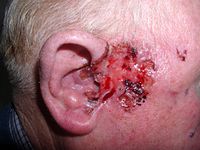
Photo from wikipedia
Background The incidence of cutaneous melanoma continues to rise rapidly and has an extremely poor prognosis. Immunotherapy strategies are the most effective approach for patients who have developed metastases, but… Click to show full abstract
Background The incidence of cutaneous melanoma continues to rise rapidly and has an extremely poor prognosis. Immunotherapy strategies are the most effective approach for patients who have developed metastases, but not all cases have been successful due to the complex and variable mechanisms of melanoma response to immune checkpoint inhibition. Methods We synthesized collagen-coding gene expression data (second-generation and single-cell sequencing) from public Gene Expression Omnibus (GEO) and The Cancer Genome Atlas (TCGA) databases. Bioinformatics analysis was performed using R software and several database resources such as Metascape database, Gene Set Cancer Analysis (GSCA) database, and Cytoscape software, etc., to investigate the biological mechanisms that may be related with collagens. Immunofluorescence and immunohistochemical staining were used to validate the expression and localization of Nidogen-2 (NID2). Results Melanoma patients can be divided into two collagen clusters. Patients with high collagen levels (C1) had a shorter survival than those with low collagen levels (C2) and were less likely to benefit from immunotherapy. We demonstrated that NID2 is a potential key factor in the collagen phenotype, is involved in fibroblast activation in melanoma, and forms a barrier to limit the proximity of CD8+ T cells to tumor cells. Conclusion We clarified the adverse effects of collagen on melanoma patients and identified NID2 as a potential therapeutic target.
Journal Title: Pharmacogenomics and Personalized Medicine
Year Published: 2023
Link to full text (if available)
Share on Social Media: Sign Up to like & get
recommendations!